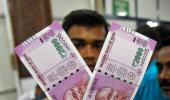The communication was clear, transparent and worded in a manner that did not induce any fear in the minds of the people, asserts A K Bhattacharya.

On May 19, 2023, the Reserve Bank of India (RBI) announced its decision to withdraw from circulation all currency notes of Rs 2,000 denomination.
The RBI circular advised the public that these high-denomination currency notes could be exchanged or deposited with banks before the end of September 30, 2023, a deadline that was subsequently extended by a week.
This was an announcement that immediately brought back memories of the 2016 demonetisation, which caused hardships and disruption to ordinary people, companies, and traders.
Long queues of customers formed outside banks as they waited to exchange the annulled currency notes of Rs 500 and Rs 1,000 denominations.
Understandably, therefore, there were serious concerns in May 2023 about the potential disruption the operation to withdraw the Rs 2,000 currency notes could cause over the following 20 weeks.
There were also questions about whether a bigger announcement on their legal tender status would be made after the deadline for withdrawal had ended.
Last week marked the end of the deadline for getting the currency notes of Rs 2,000 denomination exchanged or deposited with banks.
Over 96 per cent of the total value of these notes has already been either exchanged or deposited with banks.
What's more, over 87 per cent of these currency notes have been deposited with banks and not exchanged.
There were no long queues outside banks. There was hardly any disruption to trade or industry.
What contributed to this smooth operation? Are there any lessons to be drawn?
To be sure, the demonetisation announced on November 8, 2016, is not strictly comparable with the decision taken on May 19, 2023.
In 2016, the currency notes of Rs 500 and Rs 1,000 denominations lost their legal tender status from midnight on November 8.
In 2023, the legal tender status of the Rs 2,000 currency notes remains intact even now after the deadline for withdrawal has ended.
More importantly, the currency notes to be annulled in 2016 accounted for over 86 per cent of the currency with the public, while the May 2023 exercise implied that less than 11 per cent of the currency with the public had to be withdrawn.
Also, the sheer magnitude of the two operations was significantly different.
The 2016 exercise required the exchange of over 21 billion currency notes (17 billion notes of Rs 500 denomination and 6 billion of Rs 1,000 denomination), while in 2023, only about 1.78 billion notes had to be exchanged or deposited with banks.
Yet, there are similarities between the two operations, and it appears that the current RBI management has drawn important lessons from the disruptive and problematic consequences of the way demonetisation of 2016 was implemented.
The smooth withdrawal of over 96 per cent of the Rs 2,000 denomination notes from circulation is testimony to that.
What are the features of the 2023 scheme that made a big difference?
One, the communication was clear, transparent and worded in a manner that did not induce any fear in the minds of the people.
The messaging between the RBI and commercial banks was effectively handled so that implementation of the policy did not suffer.
The messaging of Prime Minister Narendra Modi in November 2016 was also clear and transparent, but it appeared to be aimed at triggering fear that the exercise would flush out black money from those who may have stashed it in their suitcases, hinting thereby that those in possession of such notes in large numbers could be probed by the tax authorities.
Even the RBI's communication with the banks, let alone with people, was not smooth, creating uncertainty and apprehension, which was made worse by frequent changes in the way demonetisation was to be implemented.
In addition, there was the inconvenience of immediate curbs on the usage of the demonetised notes for all transactions except a few.
In contrast, the 2023 decision imposed no curbs on the usage of the Rs 2,000 currency notes.
What also helped was the RBI's explanation of how these notes were introduced in November 2016 to meet the immediate currency requirement of the economy after the withdrawal of the legal tender status of all Rs 500 and Rs 1,000 bank notes in circulation at that time.
After achieving that objective and ensuring adequate availability of currency notes in other denominations, the printing of Rs 2,000 notes was stopped in 2018-19.
Since most of these notes, according to the RBI, were issued before March 2017 and had completed their estimated lifespan, the decision to withdraw them was taken in pursuance of its "Clean Note Policy".
Mind you, not many people were convinced by the "Clean Note Policy" argument.
Yet, the panic, if any, was subdued, because there were no immediate curbs on their usage and the deadline for exchange or deposit with banks was about 140 days.
Compare this with the 52 days given for exchanging the Rs 500 and Rs 1,000 currency notes in 2016, with very limited scope for spending them.
And most importantly, the banking system had to deal with the exchange or deposit of only 1.78 billion currency notes in 2023 over a period of 140 days, while the task was to deal with 21 billion currency notes in 2016 over about 52 days.
There is another reason for the smooth operation of the 2023 scheme.
In the last few years, the digital payment network in the country through the Unified Payments Interface, or UPI, has spread rapidly, a process expedited to a great degree by the demonetisation of 2016.
It made the task of pulling out the currency notes of Rs 2,000 denomination significantly easier.
In October 2016, the number of UPI transactions, on 26 banks associated with the system, was just about 100,000, valued at Rs 48 crore.
By May 2023, the number of banks connected to UPI had increased to 445, with the volume of transactions rising to 9.4 billion, valued at about Rs 15 trillion.
Clearly, the rapid spread of the mobile-based UPI network has minimised any possible disruptions that could have been caused by the withdrawal of currency notes in 2023.
The RBI's communication strategy in 2023, however, raised questions with respect to one of the reasons cited for its action.
It argued that the Rs 2,000 notes were to be withdrawn as they were not commonly used for transactions.
This is not borne out by the experience of traders, small businesses, and the public.
Indeed, now that the Rs 2,000 notes have been withdrawn, the pressure on lower-denomination currency notes has increased, causing avoidable inconvenience.
This has also given rise to a view that the actual reason for withdrawing the Rs 2,000 notes has not yet been revealed.
Whatever may be its actual objective, the RBI's implementation of its decision was helped by the spread of digital payments, a more effective communication policy, and, of course, the less onerous task of managing the withdrawal when compared to the huge number of currency notes to be handled in 2016.
Perhaps, having as RBI governor a person who in a different capacity had helped manage the challenges of implementing demonetisation in 2016 has its own merits.
Feature Presentation: Aslam Hunani/Rediff.com











